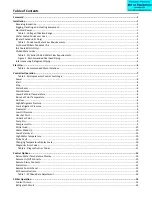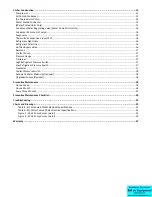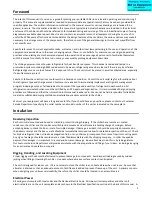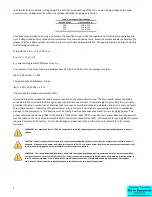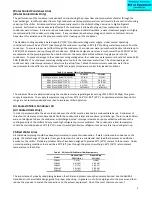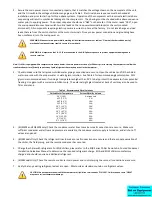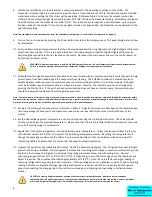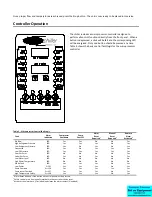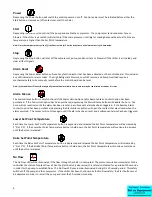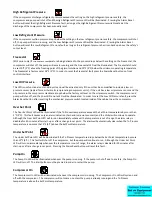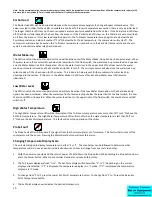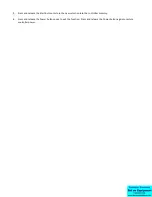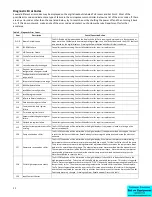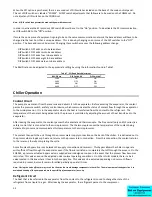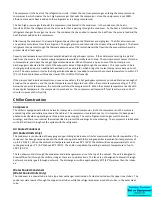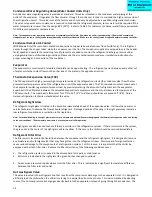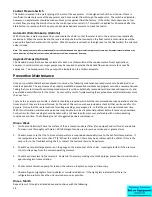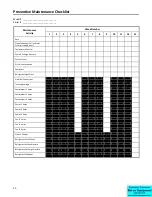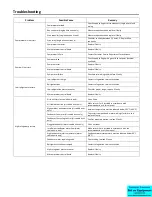
6
8.
(EQ2 series only) Make sure the Freezestat is set appropriately for the operating conditions of the chiller. The
Freezestat is located inside the main electrical control panel. It should be set at 10°F (5°C) below the minimum chilled
water temperature setting that the chiller will be operating. Reference Table 4 to be sure the coolant solution has
sufficient freeze protection (glycol) to handle at least 10°F (2.8°C) below the Freezestat setting. All chillers are shipped
from the factory with the Freezestat set at 38°F (3°C). This is done to protect against a possible freeze-up if no glycol
has been added to the coolant. Once the proper glycol solution has been added, the Freezestat can be adjusted to the
appropriate setting.
Note: The manufacturer’s warranty does not cover the evaporator from freezing. It is vital that the Freezestat is set properly.
9.
Turn on the control power by pressing the Power button located on front display panel. The panel displays should now
be illuminated.
10.
Due to extreme ambient temperatures that the unit may be exposed to during shipment, the High Refrigerant Pressure
switch may have tripped. If this is the case, disconnect the main power and reset the High Refrigerant Pressure by
depressing the manual reset button located on the switch. Reconnect the main power and turn the control power on
by pressing the Power button.
WARNING: Under no circumstance should the High Refrigerant Pressure or the Low Compressor Pressure switch be deactivated.
Failure to heed this warning can cause serious compressor damage, severe personal injury or death.
11.
Establish flow through the evaporator. Standard units are provided with an internal pump and a coolant bypass to help
protect pump from dead-heading and the evaporator from freezing. The EQ3A01 contains an automatic pressure
actuated bypass which requires no adjustment under normal operating conditions. On all other models, the bypass
must be throttled open to accommodate a “no flow to process” situation. The internal pump can be energized by
pressing the Start button. If the unit has been customized and does not have an internal pump, the external pump
should be energized to establish flow through the evaporator.
Note: The compressor will not start as long as the coolant pressure switch is open. A positive flow must be established through the evaporator before
the compressor can operate. Under certain conditions the pressure loss in process lines may not be great enough to allow the pressure switch to close.
A process throttling valve must be installed to regulate process pressure if this condition appears.
12.
Set water flow through the evaporator as indicated in Table 3. A significant increase in flow beyond the recommended
rate may damage the evaporator and create excessive pressure drops that influence the overall efficiency of the
system.
13.
Set the desired leaving water temperature on the control panel using the Up and Down buttons. The chiller should
now be controlling to the selected temperature. Please note that if there is insufficient load the compressor may cycle
on and off causing swings in temperature.
14.
Regulation of the chiller temperature is based on leaving water temperature. Unless otherwise specified, it is factory
set to deliver coolant at 50°F (10°C). Adjust to the desired operating temperature. Resetting the temperature will
change the operating conditions of the chiller. Any lower readjustment of the controller must be done only after
referencing Table 4 to ensure that the coolant has adequate antifreeze protection.
15.
Operate the system for approximately 30 minutes. Check the liquid line sight glass. The refrigerant flow past the sight
glass should be clear. Bubbles in the refrigerant indicate either low refrigerant charge or excessive pressure drop in the
liquid line. A shortage of refrigerant is indicated if operating pressures are low and subcooling is low. Normal
subcooling ranges are from 10°F (5.5°F) to 20°F (11°C). If subcooling is not within this range, check the superheat and
adjust if required. The superheat should be approximately 10°F (5.5°C). Since the unit is factory charged, adding or
removing refrigerant charge should not be necessary. If the operating pressures, sight glass, superheat, and subcooling
readings indicate a refrigerant shortage, gas-charge refrigerant as required. With the unit running, add refrigerant
vapor by connecting the charging line to the suction service valve and charging until operating conditions become
normal.
CAUTION: A clear sight glass alone does not mean that the system is properly charged. Also check system superheat,
subcooling, and unit operating pressures. If both suction and discharge pressures are low but subcooling is normal, a problem
other than refrigerant shortage exists. Do not add refrigerant, as this may result in overcharging the circuit.


